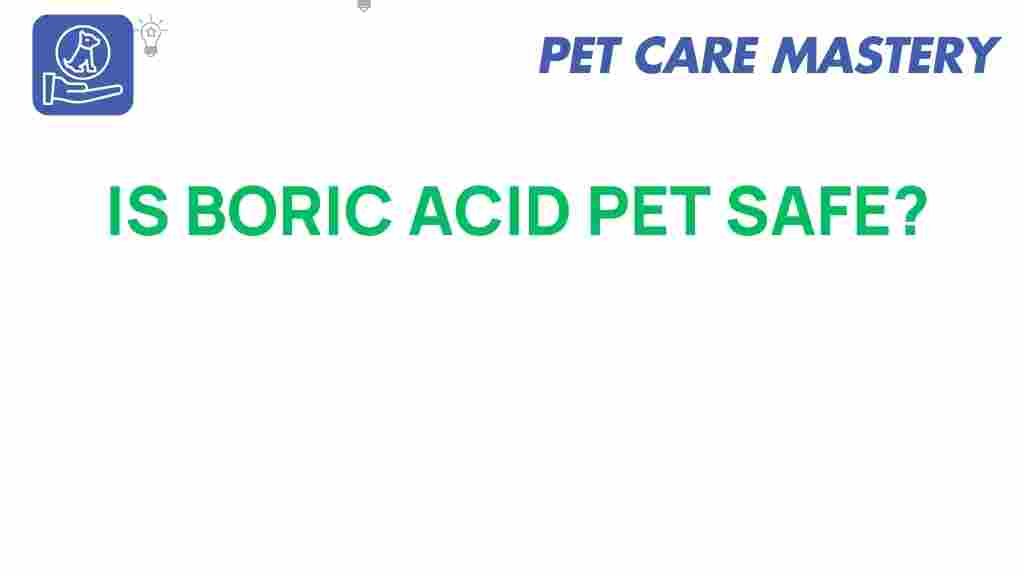Boric Acid: Is It Pet Safe for Your Home?
Boric acid has long been a popular choice for pest control, often touted for its effectiveness against insects like cockroaches and ants. However, as pet owners, many of us are left wondering: Is boric acid safe for our furry friends? In this article, we will delve into the surprising truth about boric acid, its uses, safety precautions, and how to effectively manage pest issues in a pet-friendly manner.
What is Boric Acid?
Boric acid is a naturally occurring compound that has been used for various purposes, including:
- Pest control
- Antiseptic
- pH buffer in swimming pools
- Fertilizer in agriculture
This white powder is derived from boron, a mineral found in the earth’s crust. Its effectiveness in pest control is primarily due to its ability to damage the exoskeletons of insects, leading to dehydration and death. But what about its safety around pets?
Understanding Pet Safety with Boric Acid
When discussing whether boric acid is safe for pets, it’s essential to consider the following:
- Form of exposure (inhalation, ingestion, or skin contact)
- Amount of boric acid present in products
- Species and size of the pet
While boric acid is generally considered low in toxicity for humans and pets, it can still pose risks if ingested in significant amounts. According to the ASPCA, boric acid is classified as slightly toxic to pets, especially if they ingest large quantities.
How to Use Boric Acid Safely in a Pet-Friendly Home
If you decide to use boric acid for pest control, follow these guidelines to minimize risks to your pets:
- Choose the right product: Look for boric acid products that are specifically labeled as pet-safe.
- Use in areas inaccessible to pets: Apply boric acid in cracks, crevices, and other areas that your pets cannot reach.
- Follow the instructions: Always adhere to the manufacturer’s guidelines regarding application and dosage.
- Avoid direct contact: Ensure that your pets do not come into contact with boric acid dust or granules.
- Monitor your pets: Keep an eye on your pets for any signs of distress or unusual behavior after using boric acid.
Step-by-Step Process for Using Boric Acid in Your Home
Here’s a step-by-step guide on how to safely use boric acid for pest control:
- Identify Pest Issues: Before applying boric acid, assess the areas where pests are prevalent. Look for signs of infestation such as droppings or damage.
- Choose Your Product: Select a boric acid product that is labeled as pet-safe. Check online reviews and product ingredients for added assurance.
- Prepare the Area: Clear the area of your pets and ensure that surfaces are clean and dry.
- Apply Boric Acid: Use a duster or your hands to apply a thin layer of boric acid in targeted areas, such as behind appliances, under sinks, and in cracks.
- Seal Off the Area: Ensure pets are kept away from treated areas until the product has settled and is no longer visible.
- Monitor and Maintain: Check the treated areas regularly for pest activity and reapply as necessary.
Troubleshooting Tips for Boric Acid Usage
If you find that boric acid is not effectively managing your pest issues, consider the following troubleshooting tips:
- Reassess Areas: Ensure that you are applying boric acid in all the right spots. Sometimes, pests may hide in areas that were not originally treated.
- Check for Other Factors: Pests can be attracted to food sources. Make sure to clean up any spills or crumbs that could be luring them.
- Combine Methods: Consider using boric acid in conjunction with other pest control methods, such as traps or natural repellents.
- Consult a Professional: If the infestation persists, it may be time to consult a pest control professional who can provide tailored advice and solutions.
Signs of Boric Acid Poisoning in Pets
Although boric acid is considered low in toxicity, it’s important to be aware of the signs of poisoning in pets. Symptoms may include:
- Vomiting
- Diarrhea
- Excessive drooling
- Lethargy
- Loss of appetite
If you suspect that your pet has ingested boric acid, contact your veterinarian immediately for advice and possible treatment.
Natural Alternatives to Boric Acid
If you’re concerned about using boric acid in your home, several natural alternatives can help control pests without posing risks to your pets:
- Diatomaceous Earth: This natural powder can be used to control a variety of pests and is generally safe for pets.
- Essential Oils: Certain essential oils, like peppermint and tea tree oil, can repel pests. Be cautious with essential oils around pets, as some can be toxic.
- Citrus Peels: Many insects dislike the scent of citrus. Placing peels in pest-prone areas can help keep them at bay.
- Soap and Water: A simple mixture of soap and water can be effective against soft-bodied insects like aphids.
Conclusion
So, is boric acid pet safe for your home? The answer is nuanced. While boric acid can be effective for pest control, it must be used with care to ensure the safety of your pets. By following the guidelines outlined in this article, you can use boric acid while minimizing risks to your furry companions.
If you’re looking for more information on pet safety with household products, check out this resource. And remember, when in doubt, consult a veterinarian or a pest control professional for guidance on maintaining a pest-free home that’s also safe for your pets.
This article is in the category Products and created by PetCareMastery Team
